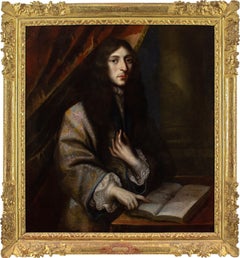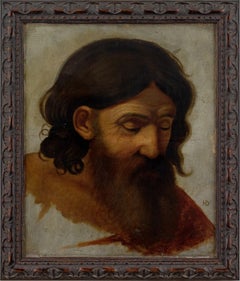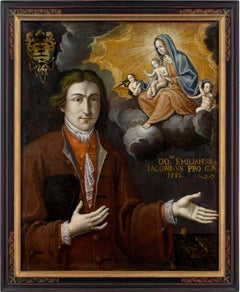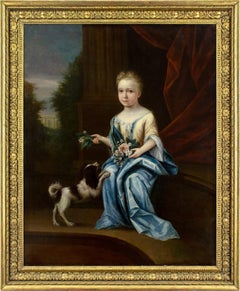Want more images or videos?
Request additional images or videos from the seller
1 of 13
UnknownEarly 19th-Century French School, Portrait Of Barthelemy Simon Louis de Medaille1807
1807
$681.97List Price
About the Item
- Creation Year:1807
- Dimensions:Height: 25 in (63.5 cm)Width: 21.5 in (54.61 cm)
- Medium:
- Movement & Style:
- Period:
- Condition:Assessed and approved by our conservator. Cleaned. Revarnished. Settled craquelure, as you would expect. The paint layer is stable. Historic repairs. Stretcher marks.
- Gallery Location:Cheltenham, GB
- Reference Number:1stDibs: LU2328214819572
About the Seller
5.0
Platinum Seller
Premium sellers with a 4.7+ rating and 24-hour response times
Established in 2017
1stDibs seller since 2023
245 sales on 1stDibs
Authenticity Guarantee
In the unlikely event there’s an issue with an item’s authenticity, contact us within 1 year for a full refund. DetailsMoney-Back Guarantee
If your item is not as described, is damaged in transit, or does not arrive, contact us within 7 days for a full refund. Details24-Hour Cancellation
You have a 24-hour grace period in which to reconsider your purchase, with no questions asked.Vetted Professional Sellers
Our world-class sellers must adhere to strict standards for service and quality, maintaining the integrity of our listings.Price-Match Guarantee
If you find that a seller listed the same item for a lower price elsewhere, we’ll match it.Trusted Global Delivery
Our best-in-class carrier network provides specialized shipping options worldwide, including custom delivery.You May Also Like
European Portrait Of A Military General
Located in Lake Worth Beach, FL
Portrait of a Military General
Fine 19th C European, Neo -Classical half-length portrait of a Military General, a handsome man wearing military regali...
Category
Mid-19th Century French School Portrait Paintings
Materials
Canvas, Oil
18th Century Portrait of a Gentleman French School Man Oil on Canvas Blue White
Located in Sanremo, IT
Painting, oil on canvas, measuring 92 x 75 cm without frame and 102 x 87 cm with frame depicting a nobleman of the French school of the first half of the 18th century.
In its formal...
Category
Early 18th Century French School Portrait Paintings
Materials
Canvas, Oil
$10,709
H 36.23 in W 29.53 in D 1.19 in
!8th Century Portrait of a Dame French School Woman Oil on Canvas Gold Blue
Located in Sanremo, IT
Painting oil on canvas measuring 92 x 75 cm without frame and 102 x 87 cm with frame depicting a rich lady of the French school of the first half of the 18th century.
In its formal ...
Category
Early 18th Century French School Portrait Paintings
Materials
Canvas, Oil
$10,709
Free Shipping
H 36.23 in W 29.53 in D 1.19 in
Portrait of a French man
By Jean Despujols
Located in BELEYMAS, FR
Jean DESPUJOLS
(Salles 1886 – Shreveport 1965)
Portrait of a Henri Martin, mayor of Saint Médard en Jalles (Gironde)
Oil on canvas
H. 75 cm; L. 60 cm
Signed lower right
around 1920/2...
Category
1920s French School Portrait Paintings
Materials
Canvas, Oil
Portrait of a man during French Revolution
Located in BELEYMAS, FR
Antoine VESTIER, attributed to
(Avallon, 1740 - Paris, 1824)
Portrait of a man under the Revolution
Oil on canvas
H. 46 cm; L. 37 cm
Circa 1793-95
This beautiful unsigned portrait i...
Category
1790s French School Figurative Paintings
Materials
Canvas, Oil
$26,473
H 18.12 in W 14.57 in
Presumed portrait of Marie-Anne de Bourbon
By Nicolas de Largillière
Located in BELEYMAS, FR
Nicolas de LARGILLIERRE
(Paris 1656 – 1746)
Portrait of a woman, presumed to be Marie-Anne de Bourbon, Princess of Conti (1666-1739)
Oil on oval canvas
H. 8...
Category
Early 1700s French School Figurative Paintings
Materials
Canvas, Oil
$48,133
H 31.5 in W 24.02 in
Portrait of a man in armor
Located in BELEYMAS, FR
Attributed to Jacques DUMONT aka DUMONT LE ROMAIN
(Paris 1701 - 1781)
Presumed portrait of Louis-Joseph de Formanoir (?-1732)
Oil on canvas
H. 91.5 cm; L. 73 cm
Signed on the helmet:...
Category
1750s French School Portrait Paintings
Materials
Canvas, Oil
The cabbage cutter
Located in BELEYMAS, FR
Jean-Baptiste SANTERRE
(Magny-en-Vexin, 1658- Paris, 1717)
The cabbage cutter
Oil on canvas
H. 86 cm; L. 70 cm
Jean-Baptiste Santerre began his apprent...
Category
Early 1700s French School Portrait Paintings
Materials
Canvas, Oil
The pianist
Located in BELEYMAS, FR
Jean CLUSEAU-LANAUVE
(Périgueux 1914 - Paris 1997)
The Pianist
Oil on canvas
H. 46 cm; W. 38 cm
Signed lower right. Countersigned, titled, and dated on the back - 1962
Provenance: E...
Category
1960s French School Portrait Paintings
Materials
Oil, Canvas
Holy family under an oak tree on a gold background
Located in BELEYMAS, FR
French school circa 1870
Holy Family under an oak, after Raphaël, on gold background
Oil on canvas
H. 92 cm; W. 60 cm
This aesthetic curiosity takes up the very famous composition b...
Category
19th Century French School Portrait Paintings
Materials
Canvas, Oil
More From This Seller
View AllJacques d'Agar (Circle), Portrait Of A Gentleman In A Silk Robe
Located in Cheltenham, GB
This enchanting late 17th-century French oil painting depicts an elegant gentleman in a silk robe with his right index finger on an open book. Stylistically, it’s comparable to the oeuvre of Jacques d'Agar (1640-1715).
Dressed in a rather ostentatious embroidered silk robe...
Category
1670s French School Portrait Paintings
Materials
Oil, Canvas
Late 19th-Century French School, Head Study
Located in Cheltenham, GB
This enchanting late 19th-century French oil painting depicts the head of a bearded man.
Rendered with an abundance of consideration and feeling, the introspection of the figure po...
Category
1890s French School Portrait Paintings
Materials
Canvas, Oil
Early-18th Century French School, Ex-Voto Portrait With Emilian Jacobin
Located in Cheltenham, GB
This splendid early 18th-century French oil painting represents an ‘ex-voto’ with Emilian Jacobin and a depiction of the Virgin Mary with Christ and angels.
Ex votos are votive offe...
Category
1710s French School Portrait Paintings
Materials
Oil, Canvas
John Verelst (Circle), Portrait Of A Young Lady With A Spaniel
By John Verelst
Located in Cheltenham, GB
This large early 18th-century full-length portrait depicts a seated young lady before a classical column and distant country house. It was formerly in the collection of Dalham Hall i...
Category
Early 18th Century Rococo Portrait Paintings
Materials
Canvas, Oil
Mid-19th-Century French School, A Pair Of Nanas, 2 x Oil Paintings
Located in Cheltenham, GB
This charming pair of mid-19th-century French School portraits depicts two grandmothers, both presumably widows, wearing black gowns and white bonnets.
Alas, the identity of these r...
Category
Mid-19th Century Portrait Paintings
Materials
Canvas, Oil
Early 19th-Century English School Portrait Of Samuel Jones Of Skeyton, Norfolk
Located in Cheltenham, GB
This fine early 19th-century English oil painting depicts Samuel Jones of Skeyton, Norfolk, smartly attired in a black coat with white cravat. The portrait was previously in the coll...
Category
1830s Portrait Paintings
Materials
Oil, Canvas
Recently Viewed
View AllMore Ways To Browse
Oil Portraits Of Fisherman
Pompeo Batoni
Princess Diana Art
Swedish Oil Portrait
Turkish Portrait
1835 Portrait
Gay Portrait
Giovanni Francesco Barbieri
Jozef Israels
Oliver Samsinger
Portrait Mourning
Portrait Of Bishop
The Lacemaker
The Red Boy
Vintage Condoms
17th Century Dress
Andre Monet
Elizabeth Taylor Painting



